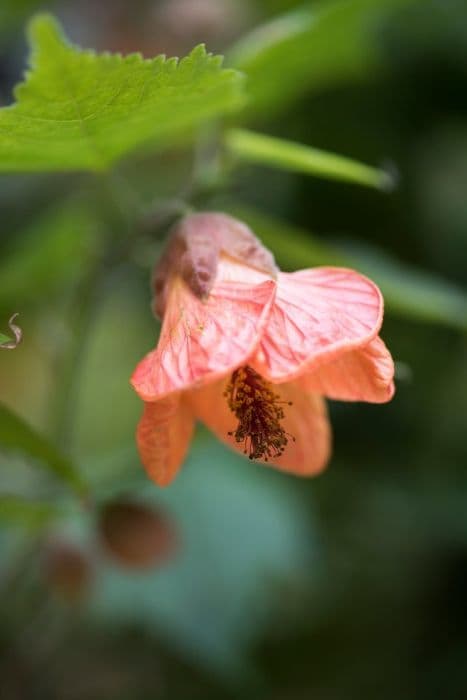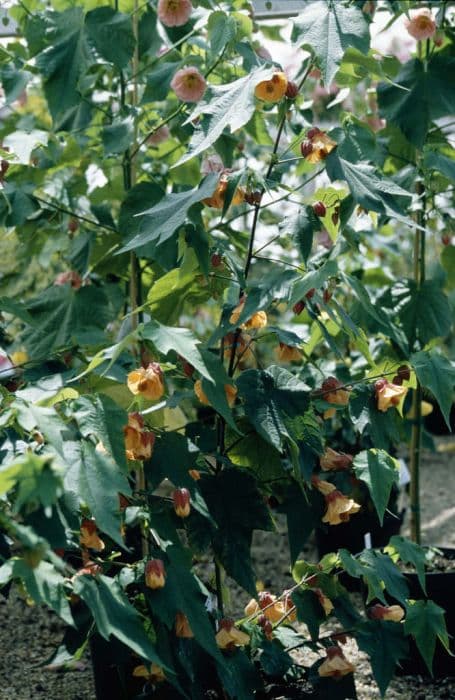Littleleaf linden Tilia cordata

ABOUT
Tilia cordata, commonly known as the small-leaved lime or little-leaf linden, is a deciduous tree that is cherished for both its aesthetic appeal and its ecological value. Without considering its dimensions, the small-leaved lime is characterized by a rounded shape with dense foliage, offering a canopy of heart-shaped, glossy green leaves that are smaller than those of other linden species. The leaf edges are subtly serrated and come to a soft, tapered point, with a somewhat asymmetrical base. During the late spring to early summer, the tree produces clusters of delicately fragrant flowers that are creamy-white and small, hanging from a leafy yellow-green bract. These blooms are a favorite of bees and are known for the rich, delicious honey produced from their nectar. In the fall, the foliage transitions to warm yellows, providing a display of autumn color. The bark of the small-leaved lime is smooth and gray when the tree is young, gradually developing into a more fissured texture as the tree matures. Its twigs are slender and brown, sometimes with fine hairs when young, transitioning to a smoother surface as they age. The fruits are small, round, and woody, carrying one or two seeds each. They dangle from the tree attached to a bract that acts like a helicopter wing, aiding in the seed dispersal by wind. The overall aesthetic of the small-leaved lime is one of understated elegance and charm, and it is commonly planted in temperate landscapes, including parks and gardens, for its beauty and the benefits it brings to the ecosystem.
About this plant
 Names
NamesFamily
Malvaceae
Synonyms
Littleleaf Linden, Small-Leaved Lime, Small-Leaved Linden, European Linden
Common names
Tilia parvifolia, Tilia ulmifolia, Tilia bohemica, Tilia europaea, Tilia pallida, Tilia sylvestris, Tilia vulgaris.
 Toxicity
ToxicityTo humans
The plant known as Small-leaved Lime is generally not considered toxic to humans. There are no well-documented cases of poisoning from ingesting any part of this plant. Therefore, it is considered safe for humans in normal quantities typically used for herbal teas or other traditional uses.
To pets
The Small-leaved Lime is also generally considered non-toxic to pets. Similar to its effects on humans, there are no significant reports of toxicity in pets from ingesting parts of this plant. Consequently, it is not known to cause harm to pets when encountered in a typical garden or natural setting.
 Characteristics
CharacteristicsLife cycle
Perennials
Foliage type
Deciduous
Color of leaves
Green
Flower color
Yellow-white
Height
65 feet (19.8 meters)
Spread
35 feet (10.7 meters)
Plant type
Tree
Hardiness zones
3-7
Native area
Europe
Benefits
 General Benefits
General Benefits- Shade Provider: Tilia cordata, commonly known as the small-leaved lime, offers considerable shade with its dense foliage, creating cooler environments beneath its canopy.
- Ornamental Value: It is aesthetically pleasing due to its heart-shaped leaves and fragrant flowers, making it a popular choice for decorative planting and landscaped gardens.
- Habitat for Wildlife: The tree attracts various insects, especially bees, due to its nectar-rich flowers, thereby supporting local ecosystems and promoting biodiversity.
- Wood Uses: The wood of the small-leaved lime is soft and workable, making it suitable for carving, turning, and making musical instruments.
- Urban Tolerant: It shows a good tolerance to urban pollution and soil compaction, which makes it an ideal tree for urban and suburban areas.
- Soil Improvement: The leaf litter decomposes into rich organic matter, improving soil quality and structure over time.
 Medical Properties
Medical Properties- Anxiolytic effects: Compounds in Tilia cordata are used for their potential soothing and calming properties, which may help to reduce anxiety.
- Sedative properties: Traditionally used to promote relaxation and improve sleep quality.
- Antispasmodic activity: May help relieve muscle spasms and gastrointestinal discomfort.
- Diaphoretic effects: Can induce sweating and is sometimes used to help break fevers by promoting perspiration.
- Anti-inflammatory action: Tilia cordata contains substances that may reduce inflammation, potentially beneficial for inflammatory conditions.
- Mild astringent properties: Can be used as a gargle or rinse to alleviate mild inflammation of the mouth and throat.
- Expectorant properties: May help in the treatment of coughs by aiding the expulsion of mucus.
 Air-purifying Qualities
Air-purifying QualitiesThis plant is not specifically known for air purifying qualities.
 Other Uses
Other Uses- Woodworking: Tilia cordata, commonly known as small-leaved lime, yields light, soft wood that is easy to work with and is used for carving and in the production of musical instruments.
- Beekeeping: This plant is highly valued by beekeepers as its flowers are rich in nectar and produce a highly regarded honey with a distinctive flavor.
- Fabric dye: The flowers and bark of the small-leaved lime can be used to produce natural dyes for coloring fabrics.
- Landscaping: Due to its attractive heart-shaped leaves and fragrant flowers, the small-leaved lime is often planted as an ornamental tree in parks and gardens.
- Animal fodder: In some regions, the leaves of Tilia cordata are used as a fodder for livestock, particularly in times of food scarcity.
- Toys: The lightweight and workable wood of the small-leaved lime is suitable for crafting wooden toys and model making.
- Aromatherapy: The scent from the flowers can be captured in essential oils and used for relaxation and stress relief in aromatherapy practices.
- Ink production: Historically, the sap of the Tilia cordata has been used as a base for inks, especially for early printing.
- Art: The soft, fine-grained wood is used by artists for detailed sculptures and as a medium for intricate woodblock prints.
- Erosion control: The tree's extensive root system can help to secure soil and prevent erosion on slopes and along riverbanks.
Interesting Facts
 Feng Shui
Feng ShuiThe Little Leaf Linden is not used in Feng Shui practice.
 Zodiac Sign Compitability
Zodiac Sign CompitabilityThe Little Leaf Linden is not used in astrology practice.
 Plant Symbolism
Plant Symbolism- Love: Often referred to by its common name "small-leaved lime," Tilia cordata has been considered a symbol of love and fidelity. It was even used in traditional wedding ceremonies in some European cultures.
- Peace: Small-leaved lime trees were commonly planted in community spaces or courts in ancient times, where people would gather to settle disputes, symbolizing peace and justice.
- Friendship: The tree's ability to draw people together has also made it represent friendship, offering a place for communal bonding and unity.
- Healing: Given its use in herbal remedies and teas to alleviate various ailments, Tilia cordata symbolizes healing and nurturing.
- Prosperity: In some traditions, the tree is associated with prosperity due to its abundant foliage and flowers, which in turn suggest growth and abundance.
- Longevity and Immortality: Due to its long lifespan, small-leaved lime is often associated with longevity and sometimes even immortality, symbolizing the cycle of life and the continuation of traditions.
 Water
WaterThe Littleleaf Linden (Tilia cordata) should be watered deeply and infrequently to encourage strong root growth, especially during the first few years for newly planted trees. Established trees typically require less frequent watering thanks to their extensive root systems. Young trees can benefit from watering of about 15-20 gallons once a week during dry periods, reducing the frequency as the tree matures. Overwatering can lead to root rot, so it's important to allow the soil to dry out between waterings. A good rule of thumb is to water when the top 2-3 inches of soil feel dry to the touch.
 Light
LightThe Littleleaf Linden thrives in full sun to partial shade. The ideal spot for the plant would allow for at least four to six hours of direct sunlight per day. Tilia cordata can tolerate some shade but will have the best growth and form when planted in an area with ample sunlight.
 Temperature
TemperatureFor the Littleleaf Linden, the ideal temperature range is between 60°F and 70°F. These trees are hardy and can tolerate a wide range of temperatures, from a minimum of -30°F to a maximum of around 80°F. The Littleleaf Linden is well-adapted to temperate climates and can handle occasional temperature fluctuations outside of the ideal range.
 Pruning
PruningPrune the Littleleaf Linden to shape the tree, remove any dead or broken branches, and to encourage healthy growth. Pruning is best done in late winter or early spring before new growth starts. It's important not to over-prune as this can stress the tree. Removing no more than 25% of the tree's canopy in a single year is a good practice.
 Cleaning
CleaningAs needed
 Soil
SoilThe Small-leaved Linden, or Tilia cordata, thrives best in a well-draining soil mix that is rich in organic matter. A blend of garden soil, peat, and sharp sand in equal parts can be ideal. Ensure the soil pH is between 6.0 and 7.5 to satisfy the plant's requirements.
 Repotting
RepottingSmall-leaved Linden trees, being slow-growing, do not require frequent repotting. Young trees should ideally be repotted every couple of years. However, as they mature, repotting can be done less often, only when the tree is pot-bound.
 Humidity & Misting
Humidity & MistingSmall-leaved Linden trees are adaptable to a range of humidity levels but prefer a moderate atmospheric moisture level. They do not require high humidity environments and can thrive in the average ambient humidity found outdoors in their natural climate range.
 Suitable locations
Suitable locationsIndoor
Use well-lit spot, avoid dry heat, water regularly.
Outdoor
Plant in moist soil, full sun or partial shade.
Hardiness zone
3-7 USDA
 Life cycle
Life cycleTilia cordata, commonly known as the small-leaved lime, begins its life cycle when a seed germinates in the spring, given suitable conditions of moisture and temperature. The seedling emerges and develops into a juvenile tree with a straight stem and a symmetrical crown of heart-shaped leaves. After several years, the tree reaches maturity and starts to produce clusters of fragrant, yellowish flowers, which are pollinated by insects, predominantly bees. Following pollination, the flowers develop into small, round fruit that contains one or two seeds. These seeds, once matured and dispersed by wind or animals, can start the cycle anew if they find a hospitable environment for growth. The small-leaved lime can live for several hundred years, during which time it will go through repeated cycles of flowering and seed production.
 Propogation
PropogationPropogation time
Early spring
Tilia cordata, commonly known as the small-leaved lime or littleleaf linden, is typically propagated by seed or by vegetative methods such as cuttings or grafting. The most popular method of propagation for this plant is through semi-hardwood cuttings. These should ideally be taken during the summer months, when the tree's growth begins to slow and the wood is not too soft or too hard. Cuttings are typically 6 to 8 inches (15 to 20 centimeters) long and should include several leaf nodes. The lower leaves are removed, and the cut end is treated with a rooting hormone to encourage root development. Then, the cutting is planted in a moist, well-draining propagation medium and kept under high humidity until roots have developed, after which it can be transplanted into a larger pot or directly into the ground.









